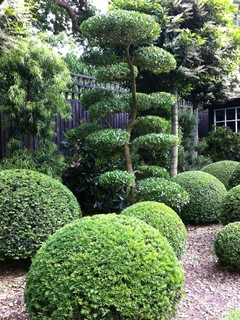THE MODERN MINT BLOG
Phillyrea is a shrub I came across a fair few years ago, in my search for clippable topiary shrubs for my own topiary work.
It seems to have been out of favour a long time – this piece about the plant by Mary Keen is from 2004, encouraging gardeners to try it out. But those 13 years pale in comparison to the last time it was popular – in the 17th and 18th centuries!
This Blog About Phillyrea Teaches You…
- Why it might be unpopular now
- Shows photos of it as beautiful topiary, as well as a mature plant
- Suggests the tool you need to prune it
- Takes advice from Architectural Plants on how to grow it
- Considers its role as a valuable plant for bees
Why Is Phillyrea Unpopular Now?
This is a tough one to answer, especially when you see how lovely the plant is…

It is a member of the olive family

Looks amazing clipped into topiary!
Cloud Pruning!
The fact it isn’t used more may have something to do with cost and availability. Most places who say they stock it will not have any available, while prices seem to vary greatly – a pre-clipped, cloud-pruned shrub will cost a lot more as you are paying for the topiarists time making it into that shape, while a normal 2 litre pot will be in the £8-10 range.
We heard from a nurseryman it is incredibly difficult to propagate, which is backed up by the Mary Keen piece on this lovely shrub.
We do not agree with her on one thing she says though…
“It seems a pity to clip the larger leafed form (latifolia) – if you must, tackle it with secateurs as you would laurel, so that the leaves are never sliced in half; this makes evergreens look dreadful. P. angustifolia can be clipped in the same way as box or holm oak.”
Nope! Shears will do just fine on this tree! Well, good shears….

Like a large head of broccoli.
How To Grow Phillyrea
Here is what Architectural Plants (where you are most likely to get a pre-cloud pruned plant) have to say about it:
“Tough as old boots. It’ll grow in sun or shade and on any soil but to get the best out of these trees they need space and light. You could say, the more exposed, the better.
It clips beautifully.
It’s only peccadillo is a terrible weakness for white fly. They’re inconvenient but there’s little you can do so ignore them.
We often sell these when restoring Tudor, Elizabethan or Mediaeval gardens. There’s masses of evidence to show that Phillyrea was used extensively hundreds of years ago. The diarist John Evelyn writes of them frequently – as if they were then as common as box, yew and holly.
What happened? They used to be so widespread and now they’re rare.
Garden historians are perplexed and so are we.”
Fantastic piece from a lovely nursery.
And check out this blog about Phillyrea from 400 years ago!
Phillyrea – Good For Bees?
Apparently, yes.
John Worlidge (who smartly advocated we make cider, not wine here in the UK, because that suited our climate better… oh how times have changed with English wine becoming the thing!) wrote in 1676:
“above any tree, the bees most affect the phillyrea; one sort of them beareth in those months (spring) an abundance of greenish blossoms, which yield great plenty of of gummy rosinny sweat, which the bees daily transport to their hives…. nothing can be more acceptable to your bees than a hedge of this tree about your apiary.”
If you can get Phillyrea cheap enough as a hedging plant, would this be worth a go?
We think so!
Finishing Up On Phillyrea…
This really is a useful plant – easy to grow, easy to keep in shape if you have a small garden, allows you to have fun with pruning tools when you give it the topiary treatment, reflects light from its leaves to brighten up the garden and can be a boon for bees.
We have planted it for one client, but will be making sure Phillyrea is down on the list of any plant schedule in the future.
And you should try growing Phillyrea too!
Further Reading: Phillyrea from nearly 400 years ago.
If you need help with any topiary or pruning in your garden, Phillyrea or otherwise, do contact me.
EBTS Boxwood Growers Forum
Through the European Boxwood and Topiary Society I worked with Chris Poole and Sue Mesher, members of the EBTS board, and we set up a Boxwood Growers Forum. This was to discuss how to make sure this wonderful topiary plant stays in the public conscioussness – we know many growers, suppliers and distributors have stopped selling it as the cost of replacing boxwood that has blight, or is nibbled by the boxwood caterpillar, makes it unviable to offer to clients and gardeners. But Boxwood is a phoenix plant, and there are ways to deal with the problems associated with Buxus. …
Modern Topiarist @ Garden Masterclass Poland
My video on Modern Topiary for Garden Masterclass has been translated into Polish, for the keen gardeners (and happy pruners!) of Garedn Masterclass in Poland. Tickets for the first showing and q and a were available here. But it will become available on the Garden Masterclass Poland website at some point in the near future – so if you are a keen clipper and want to know more, but speak Polish and not English, then I suggest you visit the website and get watching. (Of course, if you don’t speak English, you may not be able to read this…. hmmm… …
Topiary Hotline
The European Boxwood & Topiary Society are to run a Topiary Hotline for keen gardeners and people who love to clip. Date is tomorrow, April 16th 2024, and you can get a ticket for the Zoom meeting here – Topiary Hotline. Run by Chris Poole and myself, we set this up as an antidote to the huge amount of questions we have to answer about topiary throughout the summer. The plus is that their is an excitement around topiary and pruning. The problem is we need to help people in a better way… … so we will be giving people …

